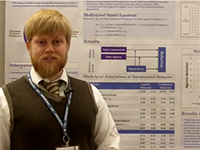Revisiting the ‘hormone of love’
It’s been more than a decade since oxytocin was first heralded as the “hormone of love”—a distinction that came with optimistic predictions for future drug therapies. It was just a matter of time before an oxytocin nasal spray would be available on pharmacy shelves, with the potential to cure shyness and dampen anxiety and, perhaps, even treat the social deficits of autism.
The excitement was not confined to the popular press. The early animal studies, which showed a link between oxytocin and sociability, generated considerable interest in scientific circles as well, and indeed led to a decade of intense study of the hormone. That search has in some ways been disappointing, producing inconsistent and weak effects, but it has not been fruitless. Instead, it has led scientists to take a still hopeful but much more nuanced view of the hormone of love. The question now is not whether oxytocin has beneficial effects, but under what circumstances does it have these effects?
That’s the view of Jennifer Bartz of the Mount Sinai School of Medicine, one of the leading researchers in an ongoing reevaluation of the evidence about oxytocin. Her position now, which she discussed this week at the meeting of the Association for Psychological Science in Washington, DC, is that the benefits of the hormone—including an oxytocin drug, in the form of a nasal spray—depend on both the person and the situation. Therapies of the future, she predicts, will be much more individualized than originally predicted
Consider the effects on emotional intelligence, or what scientists call “social cognition.” This includes our ability to detect others’ emotions, to take another’s point of view, to empathize. Several studies have shown beneficial effects on these crucial social skills—including benefits for those with disorders like autism. But other studies have found no benefits. Instead of being discouraged in this line of inquiry, Bartz has examined the results more closely and arrived at a more complex conclusion: Oxytocin appears to improve empathic accuracy for those who are socially less proficient to begin with, but not for those who are more proficient. In other words, the drug appears to improve emotion intelligence, but only for some and only to a certain level. These mixed results could still be promising for those with social deficits, such as those with autistic disorders. But an empathy drug for the general population is probably not in the cards.
Bartz has also been examining the evidence regarding oxytocin and trust. Trust is one of a suite of behaviors essential for human bonding, and the results here have also been decidedly mixed. In fact, some studies have found that oxytocin leads to the opposite of trust—envy and suspicion and insecure attachment to others. Again, however, when Bartz scrutinized the mixed findings more closely, she found an intriguing pattern: Oxytocin often boosts trust (and cooperation), but trust evaporates when other people are seen as untrustworthy—or when they are simply unfamiliar. In other words, oxytocin can enhance trust or mistrust, depending on the social situation.
These are just two examples of how the hormone oxytocin—administered as a drug—can produce paradoxical effects, effects that depend on the drug’s interaction with the individual and the individual’s life situation. These patterns of findings are also helping Bartz illuminate the basic mechanisms at play in the hormone’s effects. It might be that the hormone reduces anxiety, for example, and that dampened anxiety in turn affects emotional intelligence and trust and other skills. Or perhaps the drug works by boosting motivation to affiliate with others. Or—and this is the explanation Bartz prefers based on the evidence so far—it could be that oxytocin enhances the perception of social cues in the world. Enhancing meaningful cues—others’ facial expressions, for example—could explain both the positive and negative downstream consequences of the drug. That is, heightened social attention would be expected to magnify empathy and trust toward reliable others, but undermine them in the face of uncertainty or competition. It’s likely, Bartz believes, that all of these psychological mechanisms come into play simultaneously.
All this evidence suggests that future therapies will have to be more strategic. One possibility, Bartz believes, is that drug therapy might someday be combined with psychological interventions to produce very specific effects. For example, drug therapy might be combined with training in face processing or emotion recognition to target the deficits of autism—one of the promises first heralded more than a decade ago.
Wray Herbert’s blogs—“We’re Only Human” and “Full Frontal Psychology”—appear regularly in The Huffington Post and elsewhere. He is reporting from the 25th annual convention of the Association for Psychological Science in Washington, DC.





APS regularly opens certain online articles for discussion on our website. Effective February 2021, you must be a logged-in APS member to post comments. By posting a comment, you agree to our Community Guidelines and the display of your profile information, including your name and affiliation. Any opinions, findings, conclusions, or recommendations present in article comments are those of the writers and do not necessarily reflect the views of APS or the article’s author. For more information, please see our Community Guidelines.
Please login with your APS account to comment.